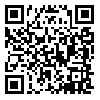Volume 1, Issue 1 (2019)
san 2019, 1(1): 186-210 |
Back to browse issues page
Download citation:
BibTeX | RIS | EndNote | Medlars | ProCite | Reference Manager | RefWorks
Send citation to:



BibTeX | RIS | EndNote | Medlars | ProCite | Reference Manager | RefWorks
Send citation to:
Aghaei M, Dagery A. The Representation of “Self” and “Other” in When We Left the Bridge. san 2019; 1 (1) :186-210
URL: http://san.khu.ac.ir/article-1-26-en.html
URL: http://san.khu.ac.ir/article-1-26-en.html
Assistant Professor of Arabic Language and Literature Mohaghegh Ardabili University , almehr55@yahoo.com
Abstract: (3568 Views)
The topic «I and others» of the topics that we want to analyze in the novel «While leaving us the bridge» by Abdul Rahman Munif, Sartre and Derrida who have shares in this area. The subject of “I and others” is a branch that originated in the embrace of philosophy and grew up to its most intense shade, and then came other epistemological branches after that, in order to enjoy these shades, and contribute to the watering of this glittering lush tree of aesthetics and to add new branches to it. This tree is naturally philosophical, and not in several eras throughout history. Perhaps with greater force and more brilliant prosperity, even for a long time Because it is one of the most prominent manifestations of the specificity of the human species and distinguish it from other organisms. In this narrative, Abdul-Rahman Munif uses the research « I and others » behind the character and incidents in his novel to show us what is the reality of thin
Type of Study: Research |
References
1. اسطيطو، عبد الرزاق (2020) «صورة المثقف في روايات عبد الرحمن منيف» ، صحيفة المثقف العدد: 4888.
2. بنیامین، والتر (1389) عروسک و کوتوله، ترجمه مراد فرهادپور و امید مهرگان، تهران: نشرگام نو.
3. توکلی، نیما (1392) دریدا و پرسش از دیگری، پایان¬نامه کارشناسی¬ارشد، دانشگاه بین المللی امام خمینی (ره) قزوین.
4. جماعة، محمد (2012) الهوية المتعددة الأبعاد، تونس: دار المشهد.
5. الخطیب، حسام (1991)، سبیل الموثرات الأجنبیة وأشکالها في القصة، دمشق. مطابع الإدارة السیاسیة.
6. دریدا، جاک (1389) بنیامین و نقد خشونت، ترجمه امیر هوشنگ افتخاری راد ودیگران، تهران: نشر رخداد نو.
7. دریدي، محمد رشدي عبد الجبار(2010) أطروحة «النص الموازی في أعمال عبد الرحمن منیف الأدبیة» الأستاذ المشرف الدکتور عادل الأسطة بجامعة النجاح الوطنیة في فلسطین.
8. الشريف، سمير (2019)«الهزيمة والمثقف المسخ وقفة مع شخصية رواية حين تركنا الجسر » موقع الجسرة الثقافي بمصر.
9. مارتن، والاس (1998) نظریات السرد الحدیثة، ترجمة حیاة محمد جاسم، المجلس الأعلی للثقافة.
10. ماکوری،جون (1982) الوجودیة: ترجمة إمام عبدالفتاح أمام. الکویت: عالم المعرفة.
11. ملایری، یدالله ومجتبی عمرانی پور (2019)«فضاء المقهى في الروایتین الفارسیة والعربیة؛ أحمد محمود وعبدالرحمن منیف نموذجاً» مجلة إضاءات نقدیة في الأدبین العربی والفارسی بجامعة کرج دوره 8، شماره 32، صفحه 90-70.
12. ملکيان، سمیه (1391) خود و دیگری در آثار فيروزه دوما، پایان¬نامه کارشناسی¬ارشد، دانشگاه آزاد اسلامی واحد تهران مرکزی.
13. منیف، عبدالرحمن (1976) «حین ترکنا الجسر»، بيروت: المؤسسة العربیة للدراسات والنشر.
14. ـــــــــــــ (1993) «الكاتب والمنفى» مقالات وحوارات ومقابلات، بيروت: دار الفكر الجديد.
15. نسایی، سمیه (1389) جایگاه دیگری در رمان جمعه یا برزخ اقیانوس آرام اثر میشل تورنیه، پایان¬نامه کارشناسی¬ارشد، دانشگاه شهید چمران اهواز.
16. ولعة، صالح (2010) «صورة المثقف العربي في روايات عبد الرحمن منيف» منتدیات ستار تایمز.
17. Istitou, Abdel-Razzaq (2020) «The image of the intellectual in the novels of Abdel-Rahman Munif», the newspaper of the intellectual number: 4888.
18. Benjamin, Walter (1389), Your Bride and Kotolah, translated by Murad Farhadpur and Omid Mehran, Tahran: Nashargham no.
19. Tawakulay, Nima (1392) Derrida and Parshesh Dagri, Pianghnam Karshnyarshid, Danshpah Bin al-Mully Imam Khomeini (may God bless him).
20. Group, Mohamed (2012) The Multidimensional Identity, Tunisia: Dar Al-Mashhad.
21. Al-Khateeb, Hussam (1991), the path and forms of foreign influences in the story, Damascus. Political management presses.
22. Derrida, Jaak (1389) Benjamin and criticism of Kheshunt, translated by Amir Hoshin, Iftikhari Rad and Dagran, Tehran: The publication of Rukhdar Nu.
23. Deridi, Muhammad Rushdi Abdel-Jabbar (2010) thesis "Parallel Text in the Works of Abdul Rahman Munif Literary" Professor Supervisor Dr. Adel Al-Osta at An-Najah National University in Palestine.
24. Al-Sharif, Samir (2019) "Defeat, the Deformed Intellect, and a pause with a novel when we left the bridge." The Egyptian Cultural Bridge website.
25. Martin, Wallace (1998) Modern Narrative Theories, translated by the life of Muhammad Jasim, Supreme Council of Culture.
26. Macory, John (1982) Existentialism: Translated by Imam Abdulfatah Imam. Kuwait: The World of Knowledge.
27. Billionaires, Evidence and Mujtaba Omrani Pour (2019) "The Café Space in the Persian and Arabic Narratives: Ahmad Mahmoud and Abdul Rahman Munif as a Model" Journal of Critical Illuminations in Arab and Persian Literature at the University of Karaj Dora 8, Shamara 32, pp. 90-70.
28. Malikyan, Sumayyah (1391) Khud and Deirri, the monuments of Ferozeh Duma, Pianangnamah Karshnaizharshd, Danshgah Azad, Islami, and one Tehran Central.
29. Munif, Abd al-Rahman (1976) "When we left the bridge," Beirut: Arab Institute for Studies and Publishing.
30. (1993) «Author and exile» articles and interviews and interviews, Beirut: Dar new thought.
31. Nasayi, Sumayyah (1389) Jaydah Dairi Dar Rumman, combined by Barzakh, Iqianos Aram, following Machel Turney, Phayanghnam Karshnasi-Arshad, Daneshgah, Shahid Kamran Ahvaz.
32. Walaa, Saleh (2010) «The image of the Arab intellectual in the novels of Abd al-Rahman Munif» Star Times forums.
Send email to the article author
| Rights and permissions | |
 | This work is licensed under a Creative Commons Attribution-NonCommercial 4.0 International License. |







